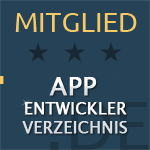
Insight

Insight

Insight
Clean Code in Flutter: My Approach to Efficient App Development


Julian Giesen
·
·
Monday, February 5, 2024


Julian Giesen
Clean Code is an essential part of Flutter app development as it requires precision and clarity. As a passionate app developer, I am aware that Clean Code is not just a technique but a philosophy that shapes our industry. Clean Code is not only a best practice but also a critical factor for successful, robust, and scalable software.
Definition of Clean Code
Clean Code is a practice that reflects professionalism and efficiency in software development. For me, as a passionate app developer, Clean Code goes beyond mere syntax – it is the art of writing code that can be easily understood not only by machines but also by humans.
In my understanding, Clean Code means that the source code is clear, readable, and elegant. It is the art of translating complex problems into simple solutions without sacrificing clarity or efficiency. Precise naming, structured functions and classes, writing tests, thoughtful error handling, and careful formatting are some cornerstones of this practice. Clean Code is the key to not only creating error-free software but also empowering teams to collaborate effectively.
With my focus on Clean Code in Flutter app development, I strive to produce code that is not only performant but also easy to extend and maintain. Because Clean Code is not just a technical necessity but also an ethical obligation to my team, my clients, and ultimately, the end users.
Why Clean Code is Important in App Development
Clean code makes the difference between average applications and extraordinary user experiences and is the key to a smooth development process, efficient debugging, and long-term maintainability.
When the code is clearly structured and well-readable, collaboration within the team is facilitated, and the likelihood of errors drastically decreases. Projects are implemented faster and remain flexible for future extensions. Clean Code is an investment in the future that extends the lifecycle of an app and minimizes the overall development costs.
My personal approach in Flutter app development aims to see Clean Code not just as a duty but as a foundation for creative innovation. Through clear structures and well-documented code, I create not only functional apps but also a basis for continuous improvement and innovation – a crucial factor in the ever-evolving world of mobile applications.
Further Reasons for Clean Code in App Development:
Increased efficiency in bug fixing
Positive impacts on user experience
Techniques and Practices for Clean Code
In the following, I will highlight some techniques and practices of Clean Code that I essentially follow during programming.
At this point, I recommend the book by Robert C. Martin “Clean Code - Refactoring, Patterns, Testing, and Techniques for Clean Code”, as well as the book “Pragmatic Programmer, The: Your Journey to Mastery, 20th Anniversary Edition” by Andrew Hunt and David Thomas. The practices I have acquired and presented are largely based on the contents of these books as well as my own experiences and their application.
Clear Naming
My approach in Flutter app development is based on clear naming as a means of communication. Each word in my code defines its function. Clear and concise labels for variables, functions, and classes are the key to understanding and maintaining the code. This makes not only the code itself but also its intentions easily understandable for every developer.
Breakdown into Meaningful Functions and Classes
The architecture of Clean Code resembles a well-thought-out book – clearly structured and easy to understand. My approach in Flutter app development includes breaking down code into meaningful functions and classes. Each function has a clear purpose, and classes are modularly structured to ensure a smart separation of responsibilities. By using code blocks, not only maintainability is improved, but also collaboration within the team.
Implementation of Tests
The implementation of tests is a way to ensure the stability and functionality of an app. By achieving comprehensive test coverage, I not only secure the quality of apps but also create a robust foundation for future developments. With a variety of unit, widget, and integration tests, I ensure that each function performs reliably and efficiently.
Consistency in Formatting
Formatting helps to support visual harmony in the code. Through the automatic formatting settings in the IDE, each section of code reflects the same clear style and structure. A consistent format is not only visually appealing but also a practical approach for teamwork. Uniform formatting rules create a common language among developers that makes the code not only more readable but also more maintainable.
Thoughtful Error Handling
Good error handling is not just a reaction but a proactive strategy. My approach in Flutter app development includes targeted error handling that not only aims to detect errors but also to prevent them proactively. Clear error messages and robust mechanisms not only ensure a smooth user experience but also allow for quick diagnosis and resolution of problems. Error handling is not just a safety net but an integral part of a stable and reliable application.
Utilization of Design Patterns
Design patterns are building blocks for a structured and scalable app architecture. By deliberately applying proven design patterns, maintainability is not only improved but also the efficiency of development is increased. Here are, among others, five essential design patterns that I successfully use in Flutter app development:
BLoC (Business Logic Component): Separation of UI and business logic for a clear structure.
Singleton: Ensuring that a class has only one instance to save resources.
Factory: Dynamic creation of objects to ensure flexibility in the codebase.
Repository: Centralized data management for unified access to data.
MVC (Model-View-Controller): Structured division of responsibilities for a clean architecture.
The skillful application of these design patterns not only facilitates development but also creates a solid foundation for sustainable and scalable apps.
Efficient Use of Clean Code in Flutter Widgets
Clean Code in Flutter widgets and the use of widget tests is crucial for successful app development with Flutter. Each Flutter widget represents not only a visual element but also an expression of precision and functionality.
1. Structured Components:
Each Flutter widget is a way to structure code into manageable components. By clearly dividing code into reusable widgets, each serving a specific function, a clear code and an easily maintainable user interface are created.
2. Separation of Concerns:
The separation of display and business logic supports a clean code structure. My approach is to ensure that widgets focus on their visual representation, while the business logic resides in separate classes or functions. This fosters clear assignment of responsibilities and enhances reusability.
3. Clean Code Principles in Dart:
Dart as a programming language enables the precise implementation of Clean Code principles. Through consistent naming, clear functions, and class structures, I create not only readable code but also ensure smooth collaboration within the team.
4. Widget Tests for Robustness:
The efficiency of my widgets is reflected not only in their visual appearance but also in their robustness through widget tests. By ensuring comprehensive test coverage, I guarantee that each widget reliably fulfills its function while maintaining the stability of the entire system.
5. Utilizing Flutter Design Patterns:
The deliberate application of Flutter design patterns such as BLoC and Provider helps to create a smart architecture where widgets are separated from the business logic. This not only improves code organization but also allows for effective management of states and resources.
Conclusion
Clean Code is not just a technique for me but a mindset that defines the quality of my apps and the joy of developing.
From precise naming to efficient use of Flutter widgets and the integration of design patterns – every aspect is aimed at creating not only performant but also elegant solutions. The emphasis on thoughtful error handling and comprehensive widget tests underscores my commitment to a reliable and stable application.
The relevance of Clean Code extends beyond technical boundaries. Through my empathetic communication, I aim not only to work effectively in the team but also to create a positive connection with clients and users. Clean Code is not just a practice – it is my signature that makes each application unique.
If you are looking for support to better structure your app and need a Flutter developer by your side who writes clean code, please feel free to contact me. I look forward to meeting you and helping you elevate your app.
All insights
All insights
“Flutter and the related logo are trademarks of Google LLC. We are not endorsed by or affiliated with Google LLC.”
“Flutter and the related logo are trademarks of Google LLC. We are not endorsed by or affiliated with Google LLC.”
Copyright ©2025. Julian Giesen. All rights reserved.
“Flutter and the related logo are trademarks of Google LLC. We are not endorsed by or affiliated with Google LLC.”






